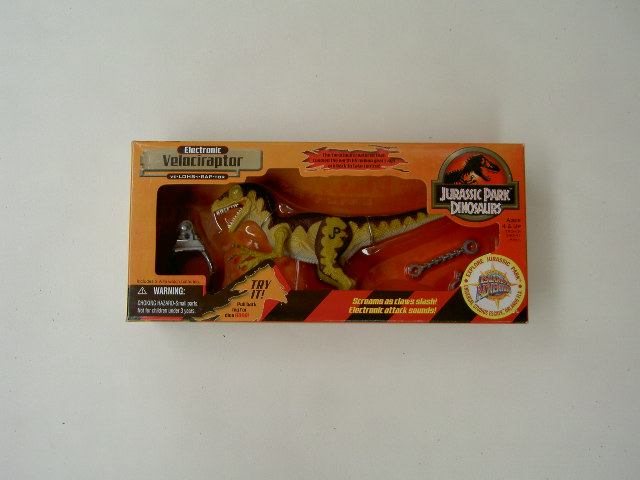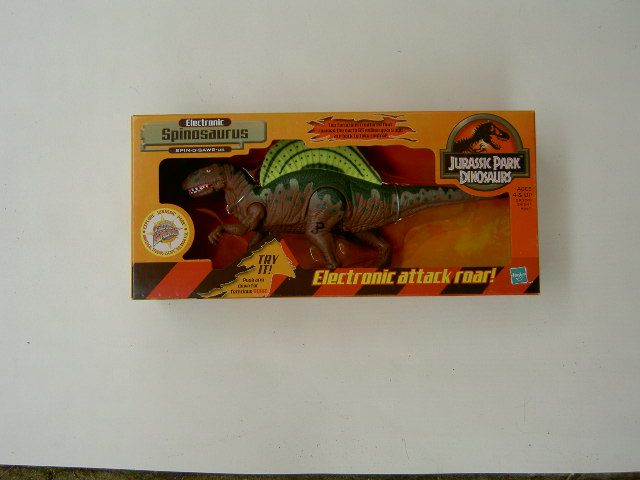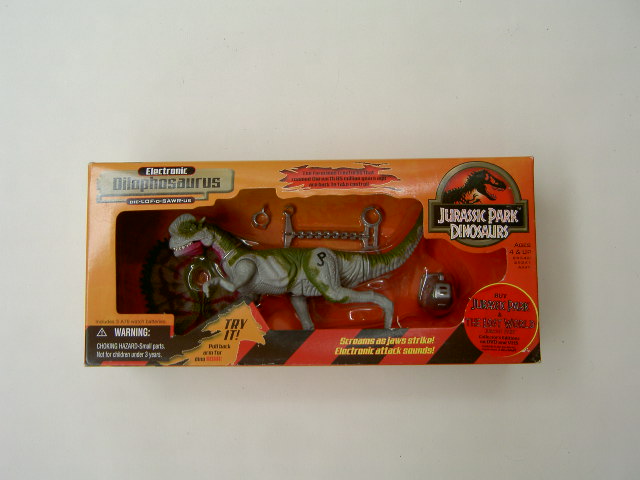Year of release: 1999
Accessories:
-Three pieces of
capture gear
Description: the
electronic Raptor of the first JP Dinosaurs line sports a wholly
different paint job than the regular Raptor figures of this series.
Its back, topside of the tail, neck and upper part of the head are
painted dark brown. This colour is also found on the sides of both
upper legs. Triangular shapes run out of this colour over the rest of
the body. The flanks, sides of the tail, rest of the legs, arms and
most of the head are coloured dark yellow. The belly, throat and
lowest part of the tail are painted beige. The creature has grey
claws on both hands and feet, including the infamous sickle shaped
claws on the feet. It has light yellow eyes with cat like black
pupils, white teeth and a red tongue. The edges and inside of the
mouth are also coloured red. On its left upper leg the figure sports
a black JP logo.
This Raptor stands in
a fully neutral pose, with its long tail slightly tilted up. It has a
more robust look to it compared with the regular Velociraptors of
this line and has a bigger, rounded head. Its mouth is opened and
can’t be closed. Unlike with most other Raptor figures the claws on
its hands are turned inward as if the beast is holding something.
This was most likely done to make the creature look more menacing
when the attack action is activated, and to help them grab other
figures. Pulling the creature’s legs back (or pulling only one leg
back, as the legs are interconnected) makes the arms move away from
each other as if the Raptor is preparing to strike. Releasing the
legs causes the arms to revert to their original position like the
critter is clutching some prey between them. Activating this strike
action also causes a loud attack scream to be heard.
This Raptor comes
with three different pieces of capture gear. There's the typical cuff
like tag with the JP logo on it, as well as an arm piece that can
hold both arms together. The big third piece can fit over the
Raptor's back. All three pieces are painted shiny metallic grey.
Analysis: this line
doesn't only return old and familiar regular dinosaur faces from the
classic days, but also some electronic ones, including this repaint
of the often fondly remembered JPS1 Electronic Velociraptor. The
sculpt has not been changed and comes with the same effective attack
option as before, trapping unfortunate human figures between its
arms, while producing a terrifying strike shriek. This sound has been
greatly improved and is now very noisy, adding to the figure's
overall intimidating feel. It's much louder than even the JPS2
Utahraptor sound, which was the same shriek but didn't sound loud
enough to come over as really frightening despite that figure being a
huge awe-inspiring Raptor. This JPD1 figure basically tells us what
the Utahraptor's shriek should have sounded like.
The paint job of this
electronic Velociraptor copies the paint scheme of its predecessor
but uses harder colour contrast making the used colours stand out
more. It's not a very original paint job (in fact, it's largely
identical to the one featured on the regular JPD1 Wave 1 Raptor
figure, which does add some consistency to this toy line), nor are
the used colours very appealing together. Details, however, have not
been omitted. Painting both the inside of the mouth as well as the
edges around it is new for this line and a definite nice touch. The
eyes could have used a different colour than yellow though, since the
rest of the face is mostly the same colour, so they don't stand out
much.
Unlike the original
JPS1 Electronic Raptor, this figure comes with capture gear. None of
the three pieces were designed for it of course, but at least they
fit. The arm piece works pretty well, and even provides some
dinosaur-breaks-free-of-restraints action. Pulling the legs back
causes the arms to separate, which often (not always in one take)
makes the arm piece detach as well. The tag is just the standard
little nuisance, the sort of thing people keep misplacing, severely
annoying collectors who try to get the figure complete when in loose
condition, all the while not having any real function but to tell
folks this is a JP figure, which of course anybody can see by the JP
logo on the figure's left leg. The big back piece is an odd addition
to the set. Though it fits, it doesn't really restrain anything.
Originally a head piece was attached to it, but that didn't fit on
this Raptor so they discarded that. Now it just sits there on the
figure's back, feeling (and being) out of place.
Repaint: yes. This is
a repaint of the old JPS1 Electronic Velociraptor, with repainted
(and in the back piece's case, slightly retooled) capture gear from
the TLWS1 small Pachycephalosaurus and TLWS2 Ornithosuchus figures,
as well as the typical tag found on many dinosaur figures from
various JP toy lines. The figure would not be repainted again.
Overall rating: 6/10.
It's still a decent Raptor sculpt with excellently enhanced sound FX,
but the paint job and capture gear aren't the best around. This is
probably the most common electronic dinosaur figure from this line,
but still not necessarily an easy find, especially MIB or complete.








